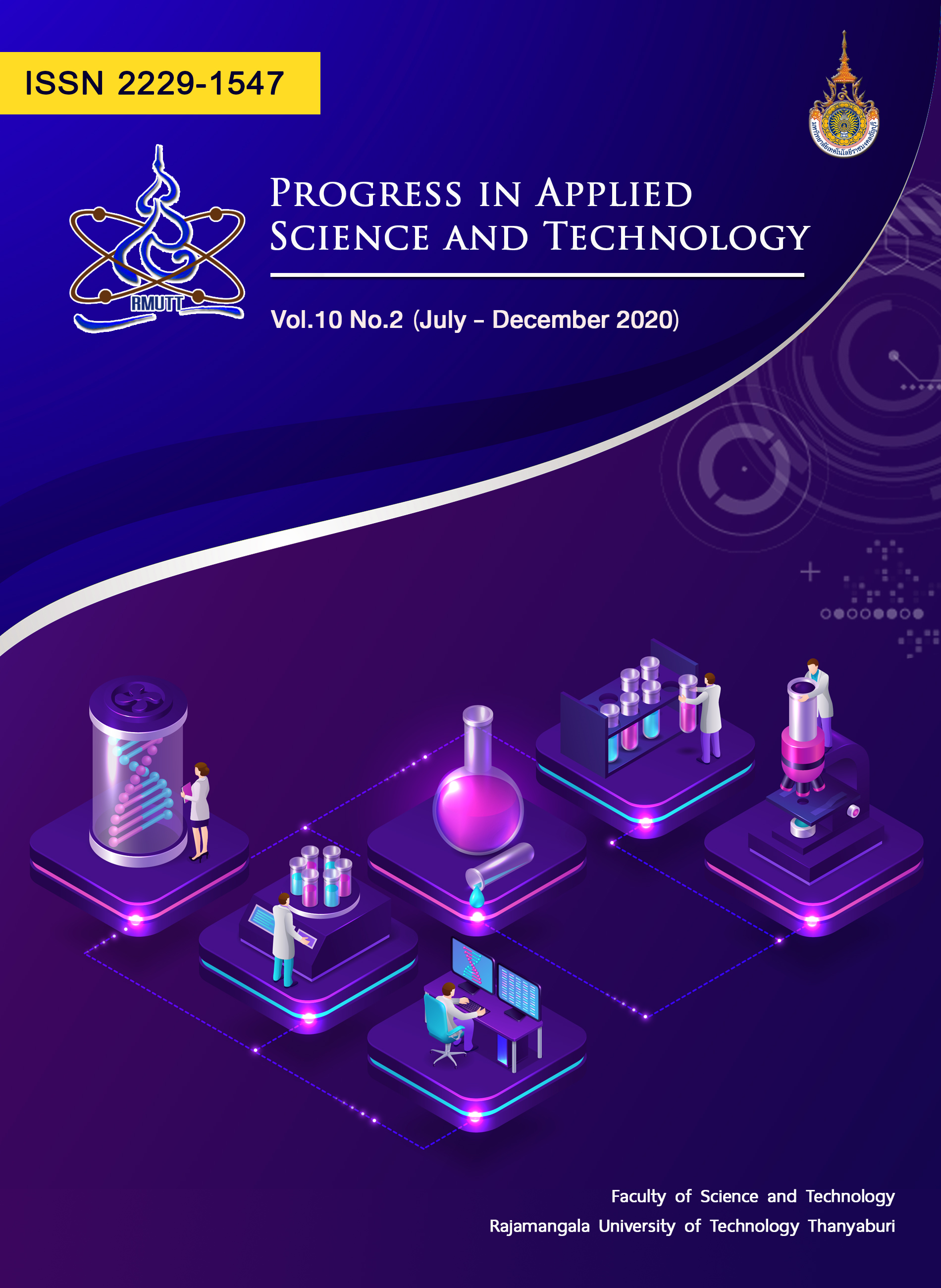Formulation and characterization of piroxicam-loaded water-in-oil microemulsions
Main Article Content
Abstract
This study aimed to investigate microemulsion (ME) formation of various non-ionic systems for seeking proper MEs to be incorporated with 0.5% w/w piroxicam. Characteristics of the obtained formulations were determined for appearance, ME type, stability tendency and in vitro drug release. ME regions in pseudoternary phase diagrams of twenty systems were constructed by titration method. The studied oil phase was either isopropyl myristate (IPM) or oleic acid (OA). The studied surfactant was either Cremophor RH 40 (RH40) or Tween 80 (T80). The studied cosurfactant was polyethylene glycol 400 (PEG400). The studied aqueous phase was either water (W) or 2:1 mixture of W and propylene glycol (2:1 W:PG). The results showed that the largest ME region was found in the system of IPM/3:1 T80:PEG400/2:1 W:PG. Six MEs (ME1 to ME6) were selected from the ME region of this system for evaluating tendency of piroxicam solubility. ME5 and ME6 were found to provide desirable drug solubility. Finally, two 0.5% w/w piroxicam-loaded MEs, designated as ME5-P and ME6-P, were prepared to be further assessed. Both formulations were clear yellow liquids and water-in-oil (w/o) type. No changes in appearance and drug contents were observed after kept at room temperature for six weeks. However, ME5-P and ME6-P exhibited slower release rates and less amounts of released drug than a commercial gel. The release limitation of the prepared piroxicam-loaded MEs may be possibly caused by high affinity between piroxicam and ME components as well as entrapment of the drug molecules within the interfacial film.
Article Details
References
Sahu CR. Mechanisms involved in toxicity of liver caused by piroxicam in mice and protective effects of leaf extract of Hibiscus rosa-sinensis L. Clin. Med. Insights Arthritis Musculoskelet. Disord. 2016;9:9-13.
Lawrence MJ, Rees GD. Microemulsion-based media as novel drug delivery systems. Adv. Drug Deliv. Rev. 2000;45(1):89-121.
Jadhav KR, Shaikh IM, Ambade KW, Kadam VJ. Applications of microemulsion based drug delivery system. Curr. Drug Deliv. 2006;3(3):267-73.
Souto EB, Doktorovova S, Boonme P. Lipid-based colloidal systems (nanoparticles, microemulsions) for drug delivery to the skin: materials and end-product formulations. J. Drug Deliv. Sci. Technol. 2011; 21(1):43-54.
Lopes LB. Overcoming the cutaneous barrier with microemulsions. Pharmaceutics. 2014;6(1):52-77.
Park ES, Cui Y, Yun BJ, Ko IJ, Chi SC. Transdermal delivery of piroxicam using microemulsions. Arch. Pharm. Res. 2005;28(2):243-8.
Nazar MF, Khan AM, Shah SS. Microemulsion system with improved loading of piroxicam: a study of microstructure. AAPS PharmSciTech. 2009;10(4): 1286-94.
Abd-Allah FI, Dawaba HM, Ahmed AM. Development of a microemulsion-based formulation to improve the availability of poorly water-soluble drug. Drug Discov. Ther. 2010;4(4):257-66.
Boonme P, Naowasan W, Tewthao U, Wuttikul K, Kaewbanjong J, Pakpayat N, Amnuaikit T. Possibility assessment of water-in-oil microemulsion for dermal delivery of piroxicam. Interprof. J. Health Sci. 2019; 17(1):1-8.
Pandey A, Mittal A, Chauhan N, Alam S. Role of surfactants as penetration enhancer in transdermal drug delivery system. J. Mol. Pharm. Org. Process Res. 2014;2:Article 113.
Ngawhirunpat T, Worachun N, Opanasopit P, Rojanarata T, Panomsuk S. Cremophor RH40-PEG400 microemulsions as transdermal drug delivery carrier for ketoprofen. Pharm. Dev. Technol. 2013;18(4):798-803.
Patel V, Kukadiya H, Mashru R, Surti N, Mandal S. Development of microemulsion for solubility enhancement of clopidogrel. Iran. J. Pharm. Res. 2010;9(4):327-34.
Wuttikul K, Boonme P. Formation of microemulsions for using as cosmeceutical delivery systems: effects of various components and characteristics of some formulations. Drug Deliv. Transl. Res. 2016;6(3):254-62.
Hlaing NHE, Pakpayat N, Boonme P. Stability and release kinetics of natural oil microemulsions containing nicotinamide. J. Cosmet. Sci. 2020;71(1): 23-35.
Dhage MA, Chhabra GS, Banerjee SK. Development and validation of UV-spectrophotometric method for piroxicam in bulk and pharmaceutical formulation. J. Chem. Pharm. Res. 2011;3(2):765-9.
Kaewbanjong J, Amnuaikit T, Souto EB, Boonme P. Antidermatophytic activity and skin retention of clotrimazole microemulsion and microemulsion-based gel in comparison to conventional cream. Skin Pharmacol. Physiol. 2018;31(6):292-7.
Songkro S, Tanmanee N, Maneenuan D, Chuchome T, Lo NL, Boonme P. Investigation of enhancing effect of Glucam®P-20 on the in vitro skin permeation of diclofenac sodium microemulsions. Lat. Am. J. Pharm. 2012;31(5):734-42.
Kajihara M, Sugie T, Sano A, Fujioka K, Urabe Y, Tanihara M, Imanishi Y. Novel method to control release of lipophilic drugs with high potency from silicone. Chem. Pharm. Bull. 2003;51(1):11-4.
Pal P, Thakur RS, Ray S, Mazumder B. Design and development of a safer non-invasive transungual drug delivery system for topical treatment of onychomycosis. Drug Dev. Ind. Pharm. 2015;41(7): 1095-9.
Mehta SK, Kaur G, Bhasin KK. Tween-embedded microemulsions - physicochemical and spectroscopic analysis for antitubercular drugs. AAPS PharmSciTech. 2010;11(1):143-53.
Djekic L, Primorac M, Filipic S, Agbaba D. Investigation of surfactant/cosurfactant synergism impact on ibuprofen solubilization capacity and drug release characteristics of nonionic microemulsions. Int. J. Pharm. 2012;433:25-33.






